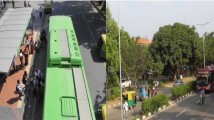Abstract
To determine how bus stop design influences mixed traffic operation near Chinese bus stops, a new theoretical method was developed by using additive-conflict-flows procedure. The procedure was extended from homogeneous traffic flow to mixed traffic flow. Based on the procedure and queuing theory, car capacity and speed models were proposed for three types of bus stops including curbside, bus bay and bicycle detour. The effects of various combinations of bus stop type, traffic volume, bus dwell time, and berth number on traffic operations were investigated. The results indicate that traffic volume, bus dwell time and berth number have negative effects on traffic operations for any type of bus stops. For different types of bus stops, at car volumes above approximately 200 vehicles per hour, the bus bay and bicycle detour designs provide more benefits than the curbside design. As traffic volume increases, the benefit firstly increases in uncongested conditions and then decreases in congested conditions. It reaches the maximum at car volumes nearly 1 100 vehicles per hour. The results can be used to aid in the selection of a preferred bus stop design for a given traffic volume in developing countries.
Similar content being viewed by others
References
IBEAS A, DELL’OLIO L, ALONSO B, SAINZ O. Optimizing bus stop spacing in urban areas [J]. Transportation Research Part E, 2010, 46(3): 446–458.
LI Xia-miao, ZENG Ming-hua, FU Bai-bai, ZHU Xiao-li. Synchronous hybrid transport network design [J]. Journal of Central South University of Technology, 2009, 16(2): 332–338.
SZETO W Y, WU Y Z. A simultaneous bus route design and frequency setting problem for Tin Shui Wai, Hong Kong [J]. European Journal of Operational Research, 2011, 209(2): 141–155.
FEDERAL HIGHWAY ADMINISTRATION. Highway capacity manual [R]. WASHINGTON D C: Transportation Research Board, 2000.
GU W H, LI Y W, CASSIDY M J, GRISWOLD J B. On the capacity of isolated, curbside bus stops [J]. Transportation Research Part B, 2011, 45(4): 714–723.
FERNANDEZ R. Modelling public transport stops by microscopic simulation [J]. Transportation Research Part C, 2010, 18(6): 856–868.
ARASAN V T, VEDAGIRI P. Simulating heterogeneous traffic flow on roads with and without bus lanes [J]. Journal of Infrastructure Systems, 2009, 15(4): 305–312.
ZHAO Xiao-mei, GAO Zi-you, JIA Bin. The capacity drop caused by the combined effect of the intersection and the bus stop in a CA Model [J]. Physcia A, 2007, 385: 645–658.
ZHAO Xiao-mei, GAO Zi-you, LI Ke-ping. The capacity of two neighbour intersections considering the influence of the bus stop [J]. Physcia A, 2008, 387: 4649–4656.
NAGAI R, NAGATANI T, TANIGUCHI N. Traffic states and jamming transitions introduced by a bus in two-lane traffic flow [J]. Physcia A, 2005, 350: 548–562.
TANG Tie-qiao, LI Yan, HUANG Hai-jun. The effects of bus stop on traffic flow [J]. International Journal of Modern Physics C, 2009, 20(6): 941–952.
WANG Dian-hai, FENG Tian-jun, LIANG Chun-yan. Research on bicycle conversion factors [J]. Transportation Research Part A, 2008, 42(8): 1129–1139.
YANG Xiao-bao, GAO Zi-you, ZHAO Xiao-mei, SI Bing-feng. Road capacity at bus stops with mixed traffic flow in China [J]. Transportation Research Record, 2009, 2111: 18–23.
KOSHY R Z, ARASAN V A. Influence of bus stops on flow characteristics of mixed traffic [J]. Journal of Transportation Engineering, 2005, 131(8): 640–643.
BRILON W, WU N. Capacity at unsignalized intersections derived by conflict technique [J]. Transportation Research Record, 2001, 1776: 82–90.
WU N. Determination of capacity at all-way stop-controlled intersections [J]. Transportation Research Record, 2000, 1710: 205–214.
LI Hai-yuan, DENG Wei, TIAN Zong, HU Pei-feng. Capacities of unsignalized intersections under mixed vehicular and nonmotorized traffic conditions [J]. Transportation Research Record, 2009, 2130: 129–137.
YANG Xiao-bao, GAO Zi-you, SI Bing-feng, GAO Liang. Car capacity near bus stops with mixed traffic derived by additive-conflict-flows procedure [J]. Science China: Technology Sciences, 2011, 54(3): 733–740.
MEDHI J. Stochastic models in queuing theory, Second edition [M]. California: Academic Press, 2002: 165–219.
Author information
Authors and Affiliations
Corresponding author
Additional information
Foundation item: Project(2012CB725400) supported by the National Basic Research Program of China, Projects(70901005, 71071016, 71131001) supported by the National Natural Science Foundation of China; Project(2011JBM055) supported by the Fundamental Research Funds for the Central Universities of China
Rights and permissions
About this article
Cite this article
Yang, Xb., Si, Bf. & Huan, M. Mixed traffic flow modeling near Chinese bus stops and its applications. J. Cent. South Univ. 19, 2697–2704 (2012). https://doi.org/10.1007/s11771-012-1329-2
Received:
Accepted:
Published:
Issue Date:
DOI: https://doi.org/10.1007/s11771-012-1329-2




